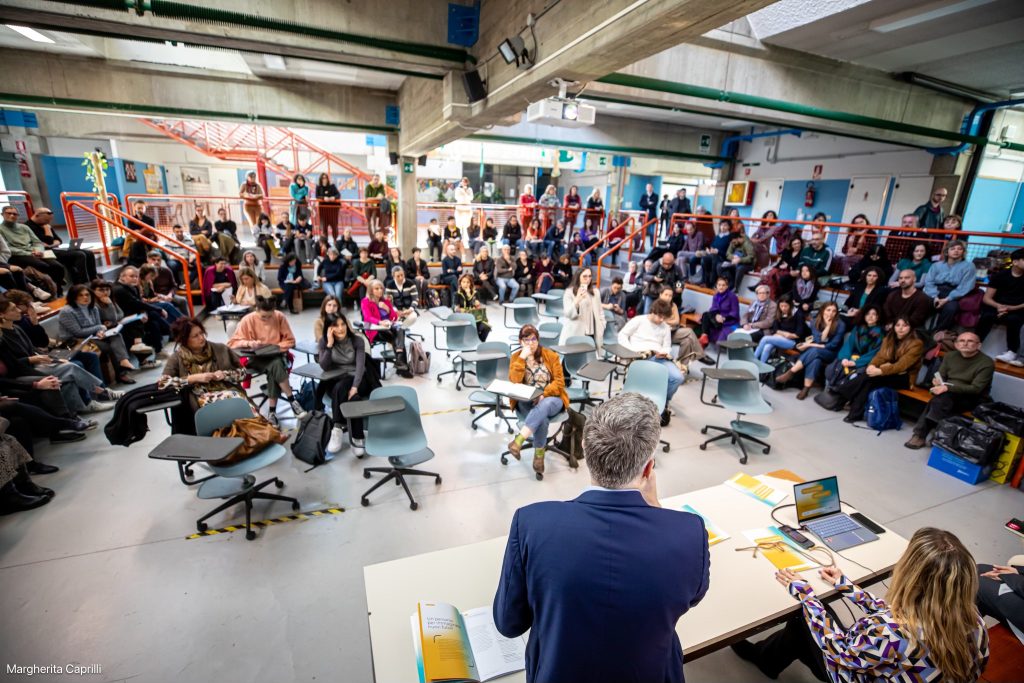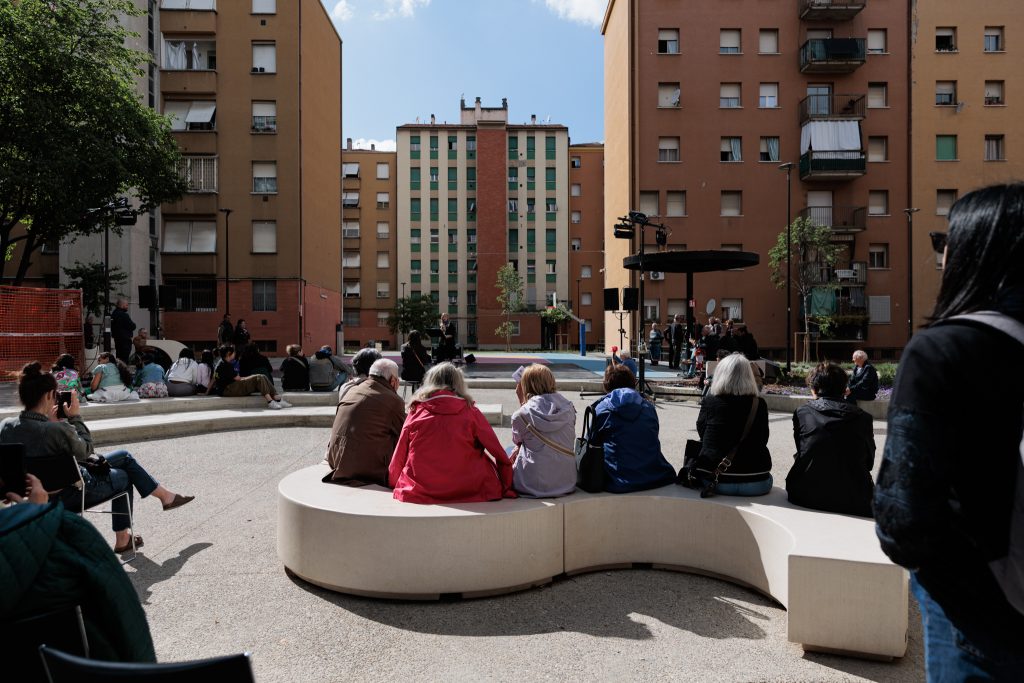The Laboratori di Quartiere (Neighbourhood labs) is a shared governance model promoted by the Municipality of Bologna, with the coordination of Fondazione Innovazione Urbana and in collaboration with the neighbourhoods. They represent democratic spaces of debate accessible to all, involving citizens and communities of the various neighbourhoods to test a new way to engage about public policies, with an intent to be more inclusive towards the communities. The participatory approach is thought of as a container that brings different opportunities to each neighbourhood every year. Participatory budgeting brings the labs to each neighbourhood, organised on the city-level where citizen involvement and deliberations have reached a consistent level of maturity, with individuals and groups genuinely eager to participate. In this interview with Erika Capasso, President, and Simona Beolchi, Process Design and Proximity Area Coordinator of Fondazione Innovazione Urbana, we explore Bologna’s deliberative journey and culture of collaboration in the last decade, the unique approaches to overcome the challenges of different neighbourhoods, and how citizen engagement benefits the entire administration, ultimately improving the effectiveness of city policies.
How did the neighbourhood labs begin?
The Laboratori di Quartiere initiative aligns with the broader framework of municipal shared governance. It began in 2017, but the city of Bologna had been on a deliberate trajectory since 2014 to actively involve residents in decision-making processes, formal city structures, and public policy development. This approach has evolved steadily over the years, leading to what is now known as shared administration.
Notably, Bologna was the first Italian city to implement regulations for the common good through collaboration pacts, subsequently adopted by over 200 other Italian municipalities as a means to foster civic cooperation for urban enhancement. In 2014, the digital platform “ParteciPA” was launched to facilitate participatory processes. The Laboratori di Quartiere are an integral part of this broader context and continue to play a pivotal role.
The collaborative approach in Bologna began in 2015 with the “Collaborare è Bologna” project, initiated by the Municipality of Bologna and conducted in partnership with the Urban Center of Bologna from 2015 to 2016. This project aimed to promote a culture of collaboration, consistently involving the community to make information, technologies, resources, spaces, knowledge, and skills more accessible.

Additionally, there was a reform of the neighbourhoods and the application of Article 118 of the Constitution regarding the principle of subsidiarity. This led to the establishment of key offices, known as network offices, in each neighbourhood, which are central to the collaboration between the Municipality and the Fondazione Innovazione Urbana operating within the city. The neighbourhood reform delineated six distinct neighbourhoods, with each office responsible for coordinating and implementing cooperation with neighbourhood associations and citizens.
In 2017, the Civic Imagination Office was created to represent the Neighbourhood Administration and since then has played a pivotal role in organising the Laboratori di Quartiere.
The city had some prior experiences before 2017, but these were specific to particular areas undergoing transformation, primarily related to urban themes and sporadic workshops. The Laboratori di Quartiere were designed to provide a more comprehensive and stable platform for citizen engagement, with a focus on social regeneration.
What is the maturity of particaptory democracy and citizen engagement in Bologna?
The administration in Bologna has been actively promoting a consultation process, with an emphasis on the importance of citizen response. Citizens in Bologna have shown a strong inclination to engage and actively participate, indicating a mature level of involvement. Both citizens and local associations in the city demonstrate a predisposition toward participation and involvement, presenting a notable challenge. The administration is working to increase the level of participation, while citizens are adapting to and comprehending the changes and new procedures, contributing to their refinement.
Simultaneously, the coordinator of the process design and proximity area points out that participation opportunities and possibilities have expanded. However, citizens, particularly those from more organised areas of the city, maintain a high standard of participation in terms of quality. These organised areas exhibit a greater inclination toward engagement and collaboration, seeking a more explicit role. The regulatory framework now incorporates co-planning and co-design, stipulating participation at various levels and stages of decision-making. This reflects the evolving landscape of citizen engagement and collaboration in Bologna.
What are the financial aspects of the process?
The funds invested by the Municipality of Bologna, concerning only participatory budgeting, are 500,000 euros per neighbourhood, adding up to a total of 3 million euros. As far as the entire scope of Laboratori di Quartiere is concerned, the process has been institutionalised and there is no separate or dedicated budget.

How inclusive is the process?
The Laboratori di Quartiere prioritises the inclusion of the most vulnerable groups. It is stated that the workshops are open to all citizens and all those interested in participating. The preparatory work is conducted by the central administration in collaboration with various departments, with the goal of broadening the participation base, including events organised by the communities themselves.
Regarding accessibility, there is ongoing collaboration with communities that previously engaged in rethinking the municipality’s accessibility policies. These communities continue to be involved in the Foundation and Administration’s joint efforts and serve as a significant point of reference for all accessibility-related matters. Additionally, tools for accessible communication, such as Italian Sign Language (LIS), have been created, and other forms of accessibility have been ensured.
When it comes to involving youth, there is a partnership with the Municipality’s InformaGiovani office. This collaboration extends to the initial information phase, proposal collection, and the voting phase, integrating various tools for a comprehensive approach.
Furthermore, detailed and specific work is carried out on a neighbourhood-by-neighbourhood and area-by-area basis. This work is contingent on the knowledge and experience of proximity agents who encounter individual situations within Islamic communities and other local realities on a daily basis. These agents play a vital role in this process.
How did the participatory process develop?
The process in Bologna involves a comprehensive exploration of the political and legal framework related to democracy and participation. Regarding the Laboratori di Quartiere, they are described as a container for various paths in each neighbourhood. These workshops serve to discuss the administration’s policies on participation, neighbourhood-specific projects, and opportunities for citizenship. The methodologies employed are not fixed but primarily aim to achieve three objectives: awareness, alignment, and discussion. For instance, recent work involved creating maps in collaboration with relevant city sectors to systematise ongoing projects and provide detailed information regarding given areas.

The Laboratori di Quartiere involves several phases. The initial phase is focused on understanding the neighbourhood itself, while some projects move into planning and design stages. These workshops provide insights into the neighbourhood’s context, identifying opportunities, problems, and critical aspects. Gamification techniques are employed to gauge citizen reactions, test gathered information, and uncover any pre-existing issues.
Participatory processes in Bologna, such as the participatory budget and the ParteciPA platform, are actively evolving. The platform serves as an information hub for updates, event scheduling, and interaction. Citizens can create profiles, activate collaboration pacts, view published opportunities, and participate in voting, making it a comprehensive digital civic collaboration tool.
Participatory budgeting in Bologna has a specific structure. It begins with engagement and territorial work, allowing people to present proposals digitally or participate in public meetings at the neighbourhood level. Unique to Bologna is the combination of digital and physical meetings, utilising presence and collaborative approaches. Workshops in each neighbourhood enable citizens to listen to others’ proposals, broaden their perspectives, and contribute their ideas.
The next phase involves bringing together the proposal submitters to meet in person to share and enrich their respective proposals. This phase is crucial for aggregating proposals and initiating project definitions. Administration technicians also participate in meetings to discuss feasibility. Following this, projects are published for public review for about 20 days before the voting phase begins. The participatory budgeting is an ongoing and complex process in Bologna, marking the city one of the a in Italy to implement such a system successfully.
What were the outcomes and lessons learned of running the labs?
The Laboratori di Quartiere has adapted and evolved in several ways over the years. The initiative has been flexible in its methodologies. Instead of adhering to fixed methods, it has adapted its approaches to suit the specific needs and challenges of different neighbourhoods in different years. This adaptability allows for a more tailored and effective engagement with citizens. Also, the participatory budgeting process has seen continuous improvement. It has included elements such as digital and physical meetings, which offer a hybrid approach to participation, ensuring broader involvement.

Lastly, the initiative has increasingly emphasised the importance of training and involving both political and administrative stakeholders. This involvement has been considered vital for cultivating a participatory culture and ensuring the success of the initiative.
What challenges did you encounter?
It is emphasised that achieving inclusivity in a participatory process goes beyond providing infrastructure alone. In the first edition of the participatory budgeting, efforts were made to produce multilingual leaflets as a means of ensuring access. However, this strategy proved to be less effective. Therefore, a shift towards a more relational approach was created, with the possibility of providing accompaniment to encourage participation. The idea is that simply translating a flyer into various languages serves as a gateway, but is insufficient in ensuring inclusivity on its own.
What are the elements that could be transferred to other contexts? What are the conditions of a successful transfer?
The Bologna experience of deliberative bodies in neighbourhoods serves as a successful model for promoting citizen engagement for others to adopt. However, replicating this model in other contexts requires certain conditions and steps. Building a participatory ecosystem necessitates inclusive training and involvement of all stakeholders, both politically and administratively. Without this commitment, it becomes challenging to cultivate a participatory culture. Even in a city like Bologna, despite a decade of progress and experimentation, such challenges persist.
It’s worth noting that citizen engagement benefits the entire administrative apparatus in various ways, going beyond political consensus to enhance decision-making and administrative processes, ultimately improving the effectiveness of city policies. To initiate this process, conducting a structural and organisational assessment of the administrative system is crucial. Proper organisation is the foundation, and it’s essential to determine how to organise participation, which professional roles to involve, and how to establish these processes.

It’s also important to note that there isn’t a universal “Bologna model” that can be copied elsewhere, as each context has its own unique characteristics. Thus, it’s crucial to involve the specific city in the process, customising participatory forms, areas, themes, and timeframes to suit the local context. This entails a gradual and thorough understanding of the specific contexts.
Concluding, strong political will is of paramount importance to drive and sustain such participatory efforts effectively.
Conclusion
Laboratori di Quartiere has several strengths, including the fact that it promotes a participatory culture and improves decision-making and administrative processes by involving citizens. However, its effectiveness strongly depends on the specific context it has been established in, which is a locality with a strong collaborative and participatory culture. Therefore, it is important to involve the city in the process, imagining the forms of participation, areas, themes and timeframe that can work best in specific circumstances. Citizen participation also requires a structural and organisational assessment of the administrative system; hence it requires a great political will for its success, which may not always be present in other contexts. Overall, the key learning from the Laboratori di Quartiere initiative is that citizen participation is essential for improving decision-making and administrative processes. The initiative demonstrates that involving citizens in decision-making processes can lead to better outcomes and to more effective policies as well as more engagement of citizens.
This case study can be found in The Toolbox of Experimental Participatory Methods, produced in the Horizon2020 EUARENAS project.


